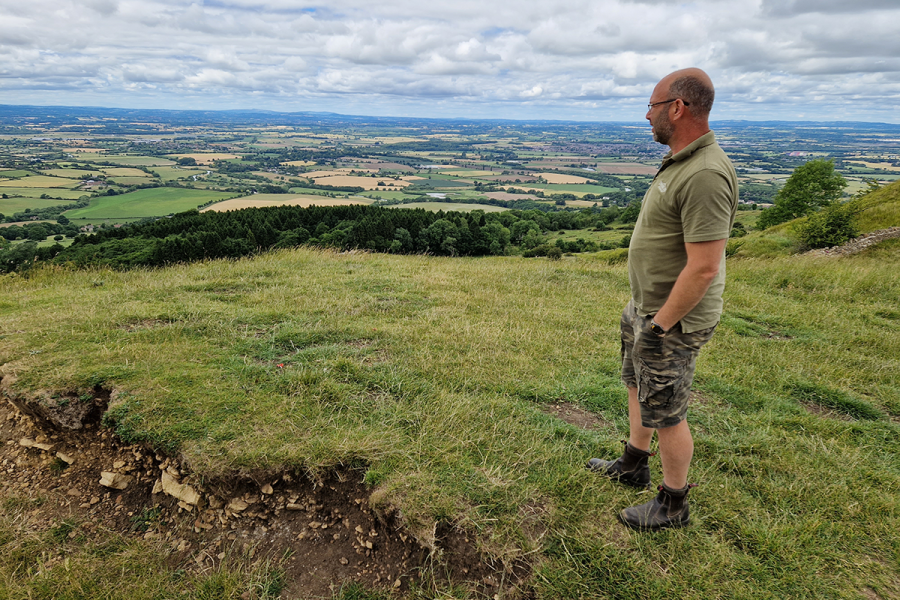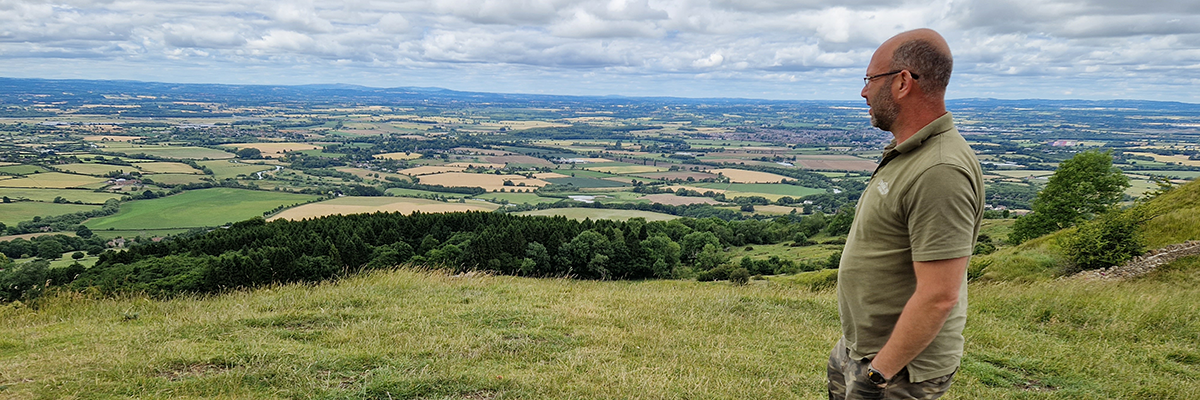
In spite of the popular narrative, profitable food production and biodiversity gain can go hand-in-hand. CPM visits Overbury Enterprises on the Worcestershire Gloucestershire border to learn how this is being achieved.
This is where I come if I feel stressed.
By Lucy de la Pasture
You can’t help but wonder if it’s a happy coincidence that the livery of the farm machinery sitting in the yard at Overbury is all green. Farming in a greener way is the ethos here.
The John Deere combine’s header is lovingly being fettled ready for the impending harvest. A green tractor and mower hurry off in the opposite direction, while another one is collecting the horse poo in the neighbouring field which forms part of Overbury Stallions thoroughbred stud.
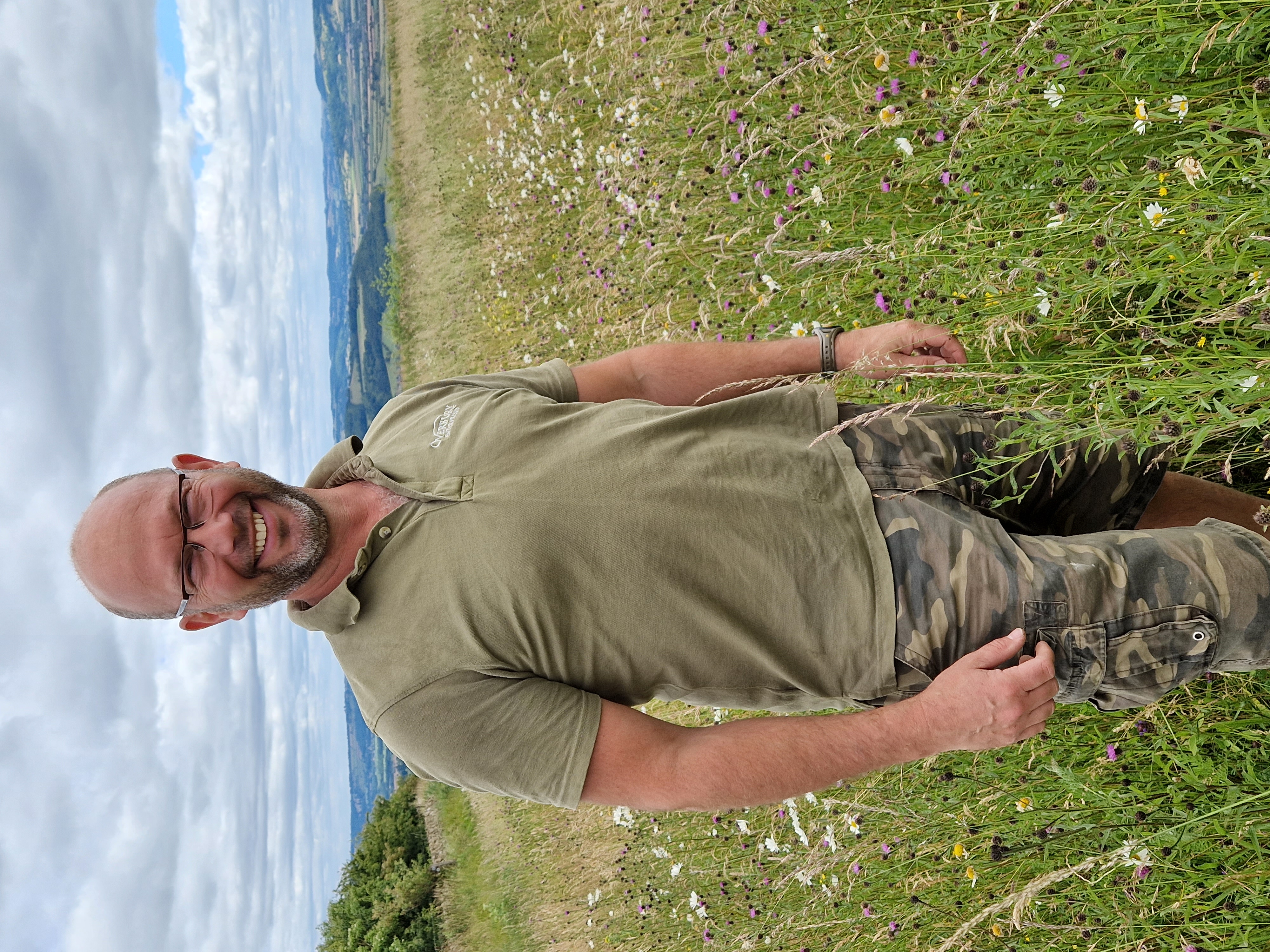
Jake Freestone views regenerative farming as an approach which has a regenerative effect on farm businesses and the environment, but says it also has to be viable from an economic perspective.
Since Jake Freestone’s tenure as farm manager began in 2003, there’s been a steady progression towards managing the 1900ha estate in a more sustainable way, 1600ha of which is farmed in-hand along with a further 207ha on contract with a neighbouring farmer. And the success of that approach is evidenced by the numerous accolades hanging on the office wall, the most recent of those being Soil Farmer of the Year in 2020 and Environmental Champion in 2021.
Yet taking pride of place are the photos of the many species of wildflowers and butterflies found on the farm and it’s very obvious that Jake’s equally as passionate about communicating the positive changes farmers can make to biodiversity to the outside world as he is about farming.
“We have a lot of farm visits and walks here, partly as that’s our commitment as a LEAF Demonstration farm but also so we can share what we’re doing here with other farmers,” he says.
Jake’s quick to point out that having the backing of Penelope Bossom, the conservation-minded owner of Overbury, has enabled the farm to transition from a system based around the plough, to intensive min-till and ultimately to a regenerative system where direct-drilling has been the mainstay since 2013.
“I’d heard the term conservation agriculture in Ireland and that made a lot of sense, but it was my Nuffield Farming scholarship in 2013 that took me down the regenerative route – though I didn’t know it was regen at the time.”
Jake views regenerative farming as an approach which has a regenerative effect on farm businesses and the environment, but says it also has to be viable from an economic perspective. “When I put together a proposal to go down this route, it was very much on a fixed costs basis – saving around £60K/year on labour, machinery costs and fuel.
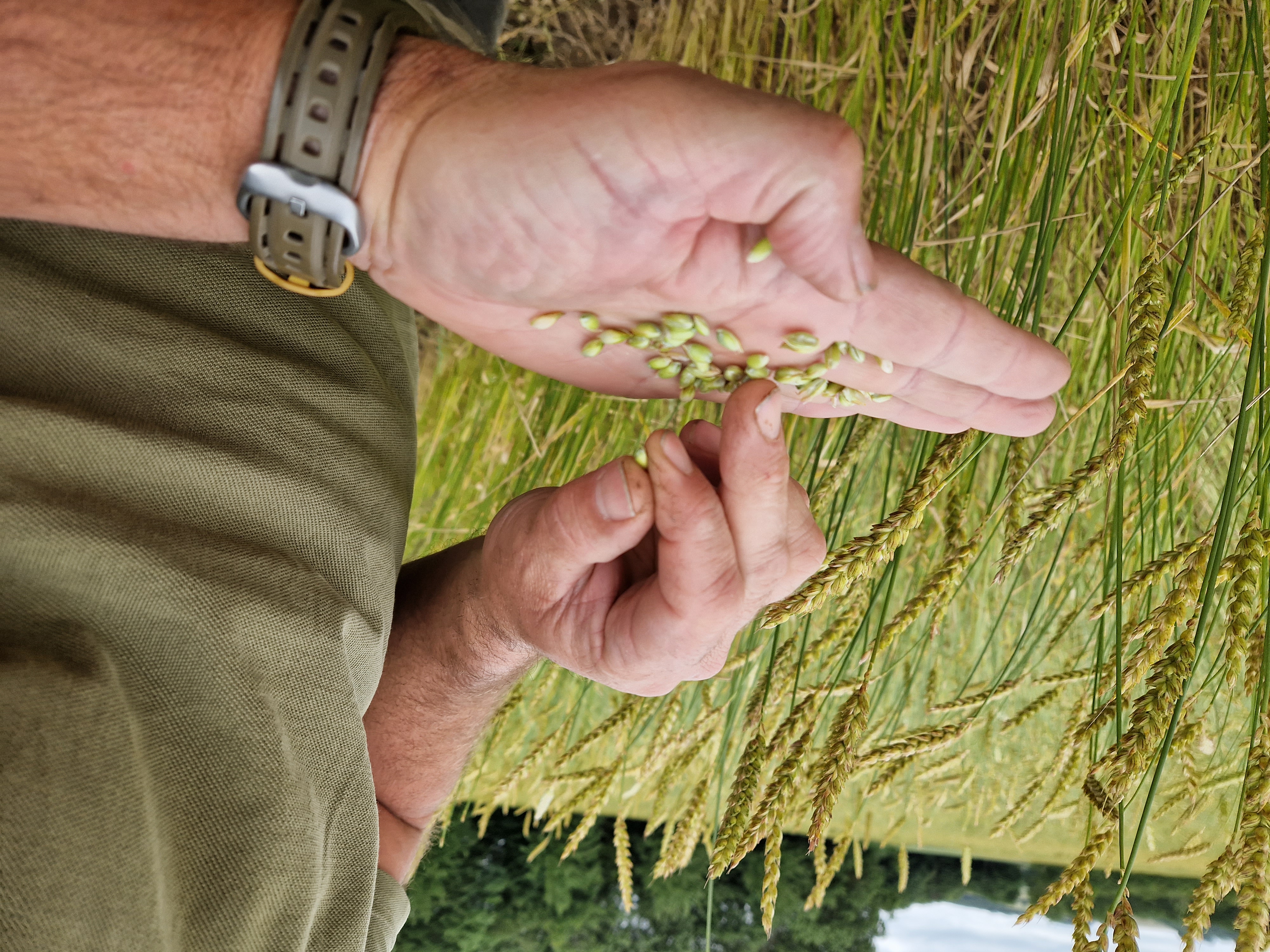
The farm is growing a relatively small area of Red Lammas heritage wheat which is used to produce heritage flour which Jake hopes will be sold with Green Farm Collective branding.
“But it wasn’t until we got into the system and started talking to people, which helped us gain confidence and enthusiasm, that we considered where we could pull back on input costs. When you start with the soil, it has an impact on everything else – cash flow, water quality, biodiversity, air quality etc.”
Water quality is one of the issues that lies close to the heart at Overbury. The farmland lies over three soil types – Evesham series clay, sand over gravel and Cotswold brash. All but three of the properties in the village of Overbury are owned by the estate and water management is critical for both the farm and the domestic properties, says Jake.
“We draw our water from springs on the hill. Once it’s captured, it’s then treated using reverse osmosis before reaching the tap. Whatever we do to the fields percolates through to the drinking water, so we have to minimise any negative impacts.
“We used to be above the limits for nitrate levels but now our water meets the legal requirements,” he adds.
It’s the change in soil management that has effected this change, explains Jake. “We know soil organic matter (SOM) is the key to water management – it can act as a sponge to hold water, and it enables water infiltration and percolation through the profile. So we designed a system to increase our SOM and only then we could start to look at our variable costs and how to cut them back without decreasing profitability.”
The emphasis on increasing SOM has been a great success, even on the sand and gravel soils where it’s notoriously difficult to achieve. “In 2005, the SOM on these soils was 1.1%, but by 2019 it had increased to 2.98%,” says Jake.
The farm has also looked very closely at its nitrogen usage, and it has been the biggest input cost saving. Soil mineral nitrogen testing is carried out on 8-9 fields a year, representing the different soil types and places in the rotation. A Yara N-sensor has been fitted on the sprayer to aid canopy management and work on nitrogen use efficiency is ongoing with Clive Blacker and the Kelloggs Origins Group.
“A crop of wheat on the heavy land used to receive 240-280kgN/ha to produce 10t/ha of milling quality wheat. Now we’re down to 175kgN/ha so we’re saving up to 100kgN/ha and maintaining yield. Last year we didn’t make milling quality, but we’ve now dropped from 50% milling wheat to 25% milling, 50% feed and 25% Group 2s and will have to see what happens this year.”
Diversity is another key principle of regenerative farming and there are a number of ways this is being achieved on the farm. Close to the yard is a small block of Red Lammas heritage wheat. It’s waving gently in the breeze on extremely long stems and looks as if a good thunderstorm could raise Jake’s stress levels quite considerably.
“We haven’t used any growth regulator but it’s something we may look at in future, or we could make use of some of the 1000 ewes on the farm,” he muses.
The heritage wheat is virtually organic, says Jake. “We have applied some herbicide, 20kgN/ha as a foliar, and this year it’s had to have a fungicide for brown rust,” says Jake. “It tillers really well so we only need 100kg/ha seed and the high biomass it produces will be increasing carbon sequestration. We’ll chop the straw but there will be a high residue to cope with, and we plan to follow in with stubble turnips.”
Heritage wheats are also deeper rooted than modern wheat varieties so more resilient to stresses. That’s evidenced by no signs of the drought stress which is visible in the nearby wheat fields on the same soil type. The grain is high value and is used to produce heritage flour which Jake hopes will be sold with Green Farm Collective branding, but he acknowledges production isn’t very scalable as combining isn’t easy and yields are around 2t/ha.
As the ground begins to rise, a block of Champion winter wheat sits with its big ears soaking up the sunshine. Sitting inconspicuously beneath it is a white clover understory which is another experiment to see how much synthetic nitrogen can be reduced on the farm.
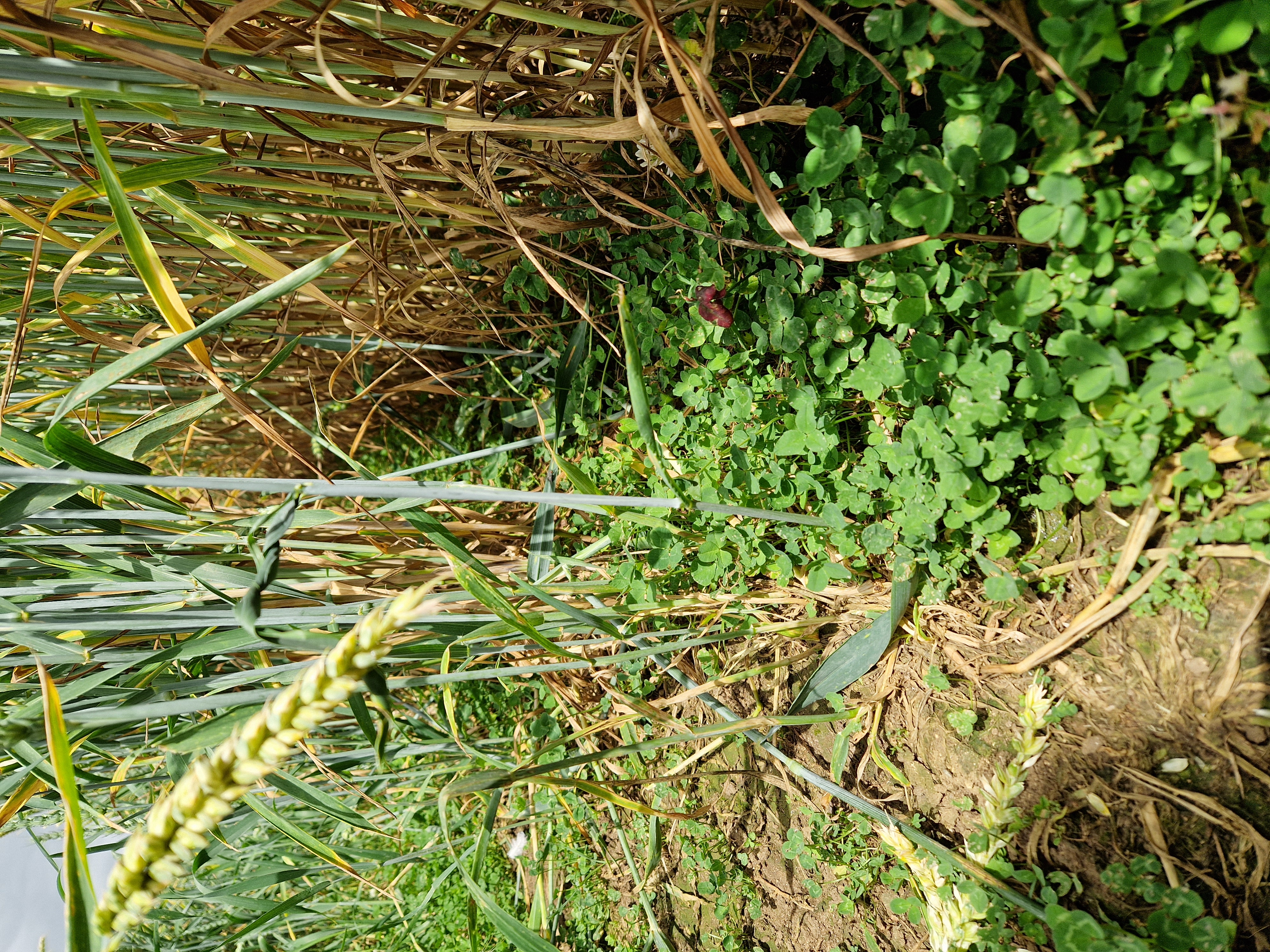
A white clover understory which is another experiment to see how much synthetic nitrogen can be reduced on the farm, with just 90-132kgN/ha applied from the bag this season.
“We planted the clover – 8kg/ha Galway and Riverdale – at the beginning of June last year after a failed crop of quinoa. In early August, we topped it to get rid of weeds and to encourage the clover to tiller. From mid-August we grazed the blocks with sheep and began planting them sequentially from 7 October through to early November, with autumn Liberator (flufenacet+ DFF) and Eagle (amidosulfuron) applied in spring for weed control.”
Mineral N tests in January found 240kgN/ha potentially available to the crop and Jake had planned just 90kgN/ha from the bag this season. “However, the N-tester indicated we needed 40kg/ha more, so most has had a total of 132kgN/ha. I may have slightly chickened out as I left some with just 90kgN/ha and I can’t see any difference.”
Jake’s fungicide programme comprised just Univoq (fenpicoxamid+ prothioconazole) at T2 and tebuconazole plus azoxystrobin at T3. “The plan will be to leave a tall stubble and chop the straw, but not too finely. Once the clover has access to light then it should grow quickly and then we’ll graze it to fatten lambs or some of the poorer ewes.
“Later on, we’ll possibly plant a second seed crop of Champion, or it’ll go into spring barley. There should be more nitrogen available from the clover in year two,” he adds.
Further up the hill there’s a field that has recently gone into a 16-species cover crop mix – forage rye, buckwheat, vetch, crimson clover, dwarf sunflower, red clover, millet, oats, white lupin, linseed, Egyptian clover, forage peas, forage rape, phacelia, stubble turnip and maize.
“We’ve generally reduced blackgrass and wild oats under no-till but we’re starting to see more meadow brome. This field has a higher blackgrass population than I’d like so we’ve put it in a cover crop this spring.”
Jake takes his fork out into the field and turns over the earth to reveal a beautiful, friable soil. Picking it up, he sniffs it and seems quite happy with its earthy, market garden smell. “Three months of carbon capture and nitrogen fixation from this cover crop works wonders. Last year it produced 25t/ha fresh weight, 6t/ha dry matter and it had 270kgN/ha in its canopy. The seed costs £80/ha but when you add up the benefits, that’s value for money.”
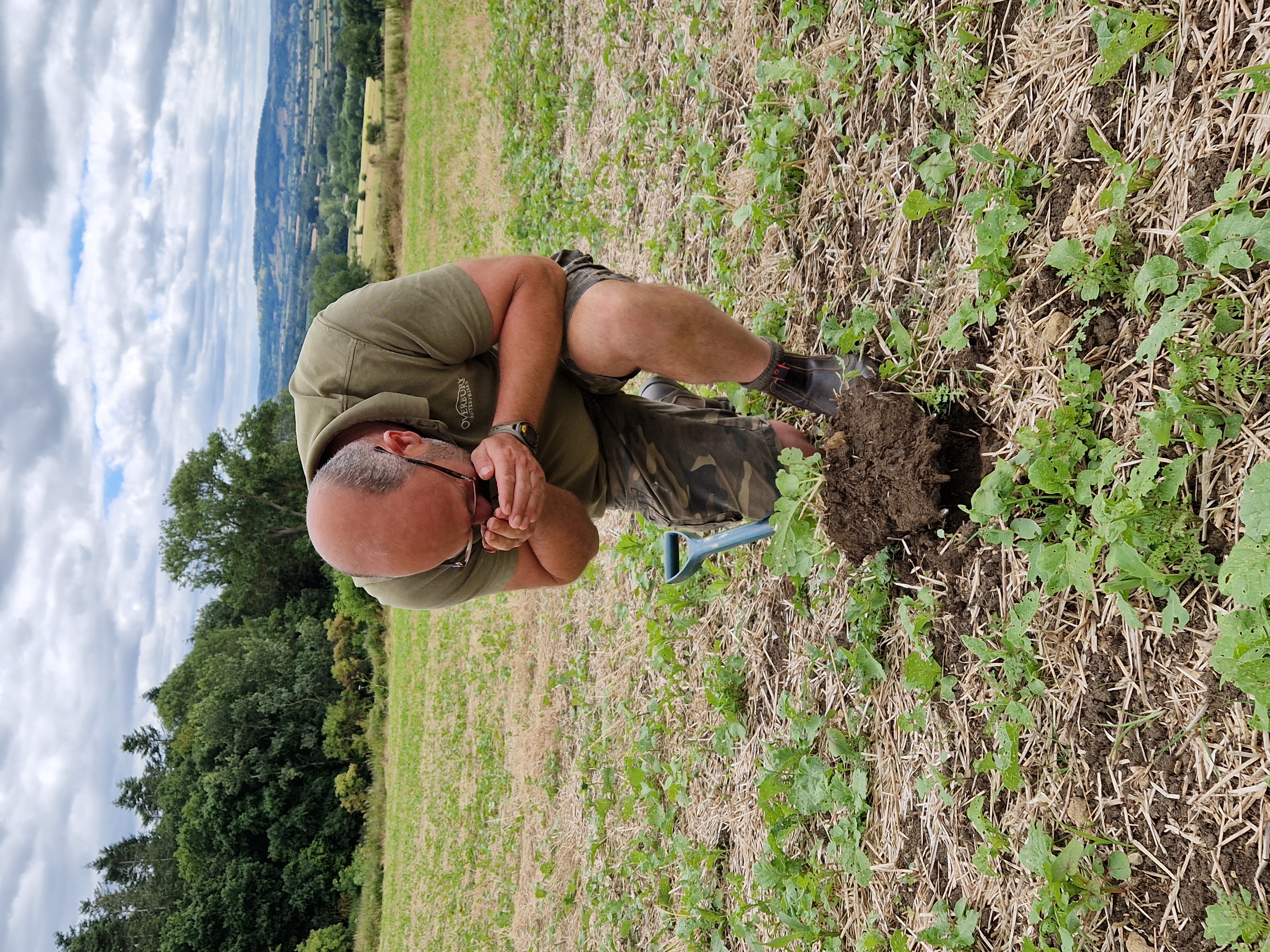
Although the spade is an indispensable tool when assessing soil, a good sniff can also tell you a lot about it.
With plenty of moisture available it’s a little warmth that some of the species in the mix are lacking, says Jake, pointing out a little yellowing in the warm C4 plant species, such as maize, sunflower and millet. In between the rows of the cover crop species, the odd blackgrass plant has emerged so Jake says the services of the sheep will be employed before it has a chance to go to seed.
“We often open the canopy by grazing with the sheep but still use glyphosate for cover crop destruction. We always apply it with fulvic acid to offset any potential damage to the soil biology,” he adds.
Heading further up the hill, orchids line the bank to the side of the track. It’s evident that wildflowers are thriving here everywhere you look – with cornflowers, yellow rattle and different poppy species existing alongside the arable cropping.
In the field above the track is a field of wheat, this time a blend of Theodore, SY Insitor and Graham. With ears at slightly different heights, the vibrant green of the Theodore amongst the other two varieties gives the field an aura of vitality that had been lost in the fields at a slightly lower altitude.
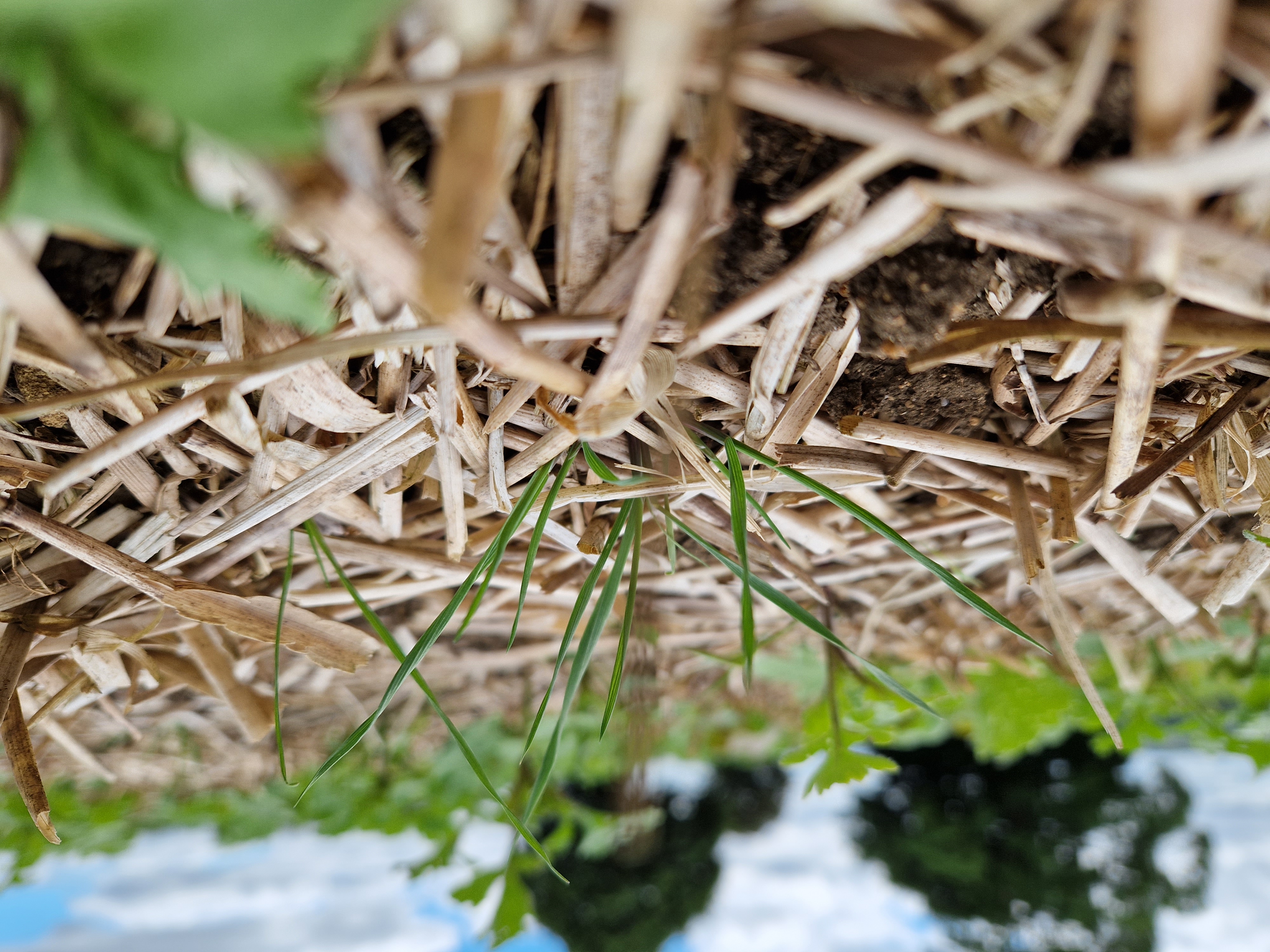
Fallowed due to blackgrass, the newly established 16-species is providing soil cover and active roots, though Jake will take care the odd blackgrass plant that’s emerged isn’t allowed to seed.
“It’s been said that the different heights of the ears improve light interception, which makes sense,” says Jake. “Funnily enough though, this field has had three fungicides instead of two which isn’t what we’d intended. The Insitor went down with yellow rust, bad enough to warrant a spray. In future I’ll have to consider which varieties I put together even more carefully.”
The tracks, which provide miles of permissive walks and bridleways across the farm, become more overgrown and grassier. “We leave them like this so that it discourages dogs from leaving the path,” he adds.
“And that’s another reason the birdlife is also thriving on the farm, we have more cover and more food in the regenerative system, particularly since insecticides were dropped – which were the first input to bite the dust on the farm.
“Fourteen barn owl chicks have been rung this spring and as an apex predator, it indicates we have a properly functioning soil food web.”
As he speaks, a skylark rises from the ground and sits on a fence post by the car, casually observing its occupants without a care in the world. As Jake turns off the engine and reaches for his camera, she decided she’d seen enough and flies off before there’s a chance to take a snapshot.
Nearing the top of the climb, oilseed rape is ripening steadily. “Crops are usually a week to 10 days behind up here,” says Jake.
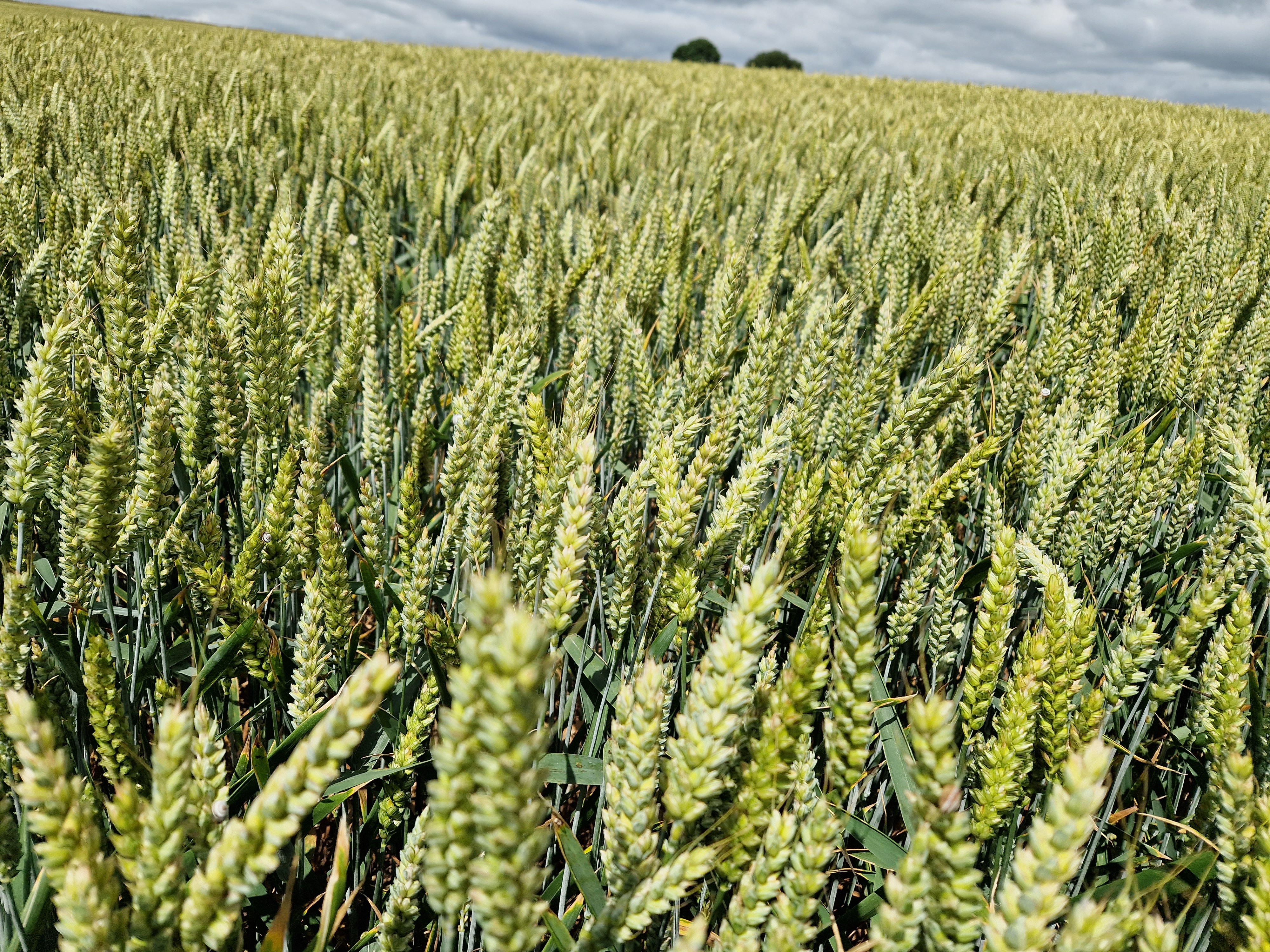
With ears at slightly different heights, the vibrant green of the Theodore amongst the blend of Graham and SY Insitor, giving the field an aura of vitality.
The farm has opted to grow hybrids with good autumn and spring vigour, as well as adopting other cultural strategies to minimise cabbage stem flea beetle damage. “We leave a high winter barley stubble, chopping the straw, and then we apply poultry manure. We direct drill OSR, which preserves moisture and places the seed to an even depth which helps give an even emergence – diluting any CSFB pressure.
“We’ve also been companion cropping since 2014, using vetches, berseem clover and buckwheat. We used to add phacelia too but we’ve had trouble taking it out with Astrokerb (propyzamide+ aminopyralid) so we’ve dropped it from the mix,” explains Jake.
At the very top of the hill lies an area of grassland which is home to a hill fort, listed as an ancient monument – the history is palpable. On the site is a tower, the top of which marks 1000 feet above sea level, and from here there is a 360⁰ view of the surrounding countryside – with seven counties laid out in vast patchwork beneath us.
“This is where I come if I feel stressed,” says Jake and it’s easy to see why.
Leaving the hill fort, he suddenly slows down and leans out of the window. “I think that’s a marbled white butterfly,” he says excitedly. It’s plain to see that the biodiversity on the farm is as much Jake’s passion as the farming and that the two things can exist hand-in-hand.
Footnote: Overbury was visited on 4 July 2022
This article was taken from the latest issue of CPM. For more articles like this, subscribe here.

